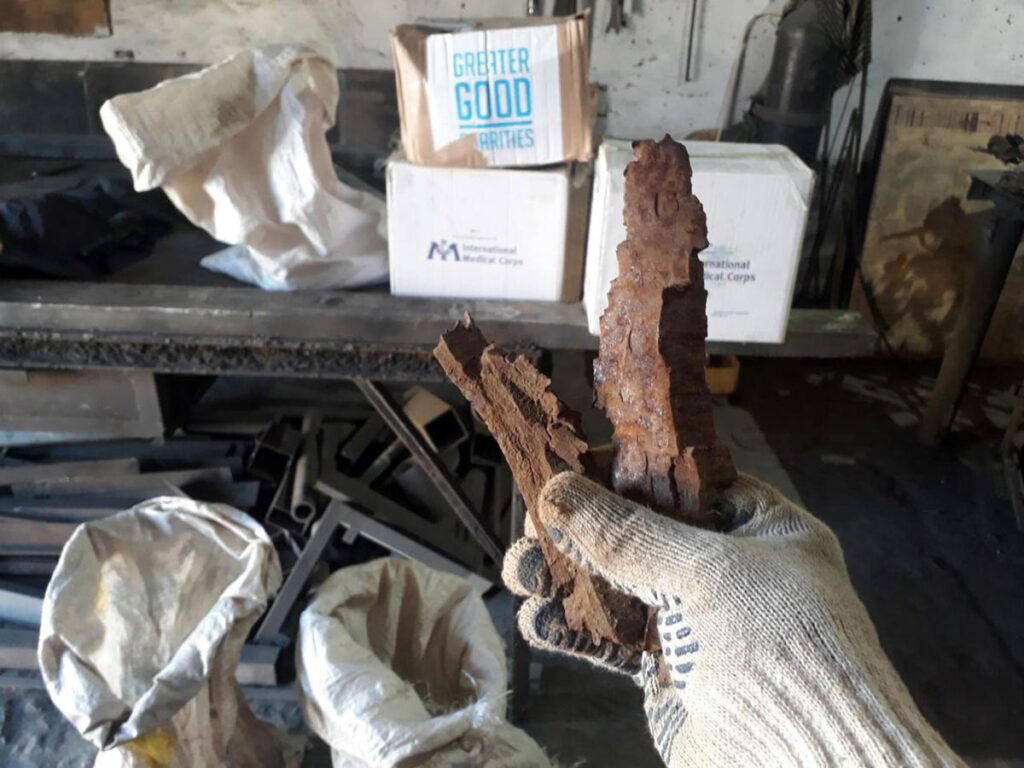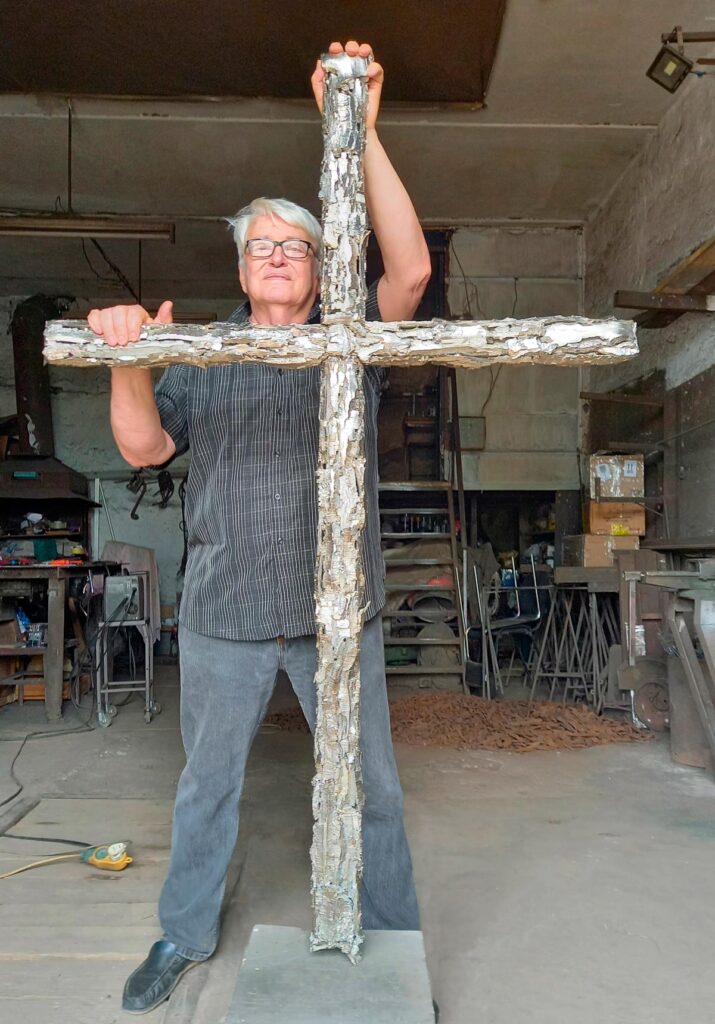The Art of MFF
A Modern Prophet with a Welding Torch
Sergey Melnikoff (MFF): Forging Peace from Shrapnel — A New Movement in Contemporary Art
Through the deliberate use of ammunition remnants sourced from battlefields, Sergey Melnikoff establishes a contemporary artistic trend that transmutes instruments of destruction into icons of moral regeneration and victory over evil.
In the wake of war’s devastation, where destruction and death are the dominant narratives, American artist Sergey Melnikoff—known artistically as MFF—has emerged as a radical voice, challenging the traditional boundaries of contemporary art. His latest body of work marks the inception of a groundbreaking artistic movement: the transformation of ammunition fragments, collected from active combat zones, into spiritually charged sculptures. These works do not merely evoke reflection—they redefine the role of contemporary art as a medium of historical testimony, moral resistance, and metaphysical dialogue.
Art as Moral Testimony
Melnikoff’s artistic vision is rooted in a profound moral imperative: to confront violence by giving it a soul. His sculptures, composed of real shrapnel and shell casings retrieved from Ukrainian battlefields such as Kherson and Kharkov, are not abstract commentaries on war—they are its physical remnants. These materials, once instruments of destruction, are painstakingly reworked into objects of beauty and reverence. In doing so, Melnikoff establishes a powerful contrast: what once tore human flesh now seeks to heal collective memory.
The act of transforming deadly debris into sacred forms functions as an act of redemption. The metal, saturated with history and human suffering, is not sanitized but preserved and elevated. By refusing to disassociate the material from its violent origins, Melnikoff forces the viewer to confront the brutality of war while simultaneously offering a vision of hope and transcendence.
Created on the Frontline
It is crucial to note that all of Melnikoff’s works are created on the territory of Ukraine. A successful American artist by career and reputation, he made the deliberate choice to live and work inside an active war zone. His studio is located in Odesa – a city actively shelled by the Russian forces. The shrapnel he uses is not purchased or outsourced—it is personally collected by the artist from the line of combat resistance. This raw proximity not only enhances the authenticity of his art but imbues it with a sense of lived danger, sacrifice, and unfiltered truth.

Aesthetic Innovation: Beyond Found Object Art
While Melnikoff’s approach shares conceptual ground with found-object art—where everyday items are recontextualized as art—his work diverges in intention and emotional gravity. In contrast to Duchamp’s urinal or Warhol’s soup cans, which critique consumer culture or institutional authority, Melnikoff’s sculptures function as memorials and prayers. His pieces are not ironic—they are elegiac.
His use of cold-forged stainless steel machine-gun casings, gold electroplating of artillery fragments using 999.9 fine gold, and precision welding of even the smallest metal shards lends his sculptures not only visual refinement but also conceptual depth. The juxtaposition of crude war metal with noble finishes symbolizes a spiritual alchemy: the transmutation of destruction into beauty, of brutality into mercy.
The Cross as Archetype
Central to Melnikoff’s work is the Christian symbol of the cross, reinterpreted not as a passive emblem but as a militant icon of resistance and resurrection. One of his most spiritually resonant works is The Cross — Voice of the Land, forged from artillery shell fragments collected in Kherson and Mykolaiv and finished in nickel. Modeled in the Catholic tradition, it features a powerful form rooted in the pain, dignity, and resilience of the Ukrainian people. This sculpture, though forged from war, emerges as a beacon of hope and transcendence, suitable for sacred or diplomatic spaces.
An even more monumental expression of his vision is The Cross of Peace with the Golden Crucifix—a towering sculpture standing over four meters tall, with a radiant golden figure of Christ at its center. Conceived as a universal symbol of faith’s triumph over evil, the work draws its power from contrast: the glowing Crucifix set against the raw fragments of war becomes a spiritual parable of compassion, forgiveness, and divine light piercing through darkness.
Another landmark creation by MFF is The Holy Mandylion—a relief that fuses Byzantine iconography with modern materials and the spiritual resonance of war. The face of Christ, modeled in sacred geometry, is composed entirely of original artillery shrapnel fragments—none of which were mechanically altered or reshaped. Instead, these raw shards were painstakingly selected and layered in six intricate levels, giving the image a sculptural depth and haunting dimensionality. The “veil” itself is forged from flattened high-caliber machine gun casings, electroplated in 999.9 fine gold. This work is simultaneously an icon, a document, and a prayer—an embodiment of timeless faith forged from the materials of a contemporary battlefield. Though rooted in ancient visual tradition, The Holy Mandylion speaks urgently and intimately to the modern viewer, searching for traces of God amid destruction.
What sets MFF’s sculptures apart in the eyes of collectors and connoisseurs of fine art is his unwavering commitment to using only unaltered battlefield fragments in the central elements of his works. These are not reshaped or polished; their raw, jagged forms remain intact—preserving the truth of their origin. In his monumental installation The Cross of Peace, the crucified figure of Christ is assembled from over 20,000 micro-shards, most no larger than a child’s fingernail. The resulting form is not only a feat of technical virtuosity but a spiritual act of redemption—each fragment a splinter of suffering transformed into light. This mosaic-like process transforms the very medium of war into a testament of faith.
War as Material, Peace as Message
In a world increasingly desensitized to images of violence, Melnikoff’s use of actual war remnants reinvigorates the communicative potential of contemporary art. Rather than relying on spectacle or shock, he trusts the material itself to speak. Each piece of shrapnel carries not only physical weight but narrative density—stories of explosions, of lost lives, of battles fought in darkness and mud.
Yet Melnikoff’s message is never one of despair. The very act of transforming this debris into sculpture is an act of resistance against hopelessness. By giving form to what was formless, by inscribing meaning onto what was mute, he affirms art’s enduring power to reclaim humanity from the ruins.
A Spiritual Vanguard
Melnikoff’s movement cannot be confined to traditional labels—be they postmodern, expressionist, or symbolic. His work is sui generis: a convergence of war documentary, religious artifact, and philosophical inquiry. More than an aesthetic experiment, his sculptures serve as instruments of spiritual diplomacy. They are intended for sacred and institutional spaces—churches, embassies, museums—that stand as guardians of cultural memory and moral conscience.
In this sense, Melnikoff operates not just as an artist, but as a cultural emissary—an ambassador of memory, peace, and human dignity. His sculptures may one day populate museums and auction catalogs, but their true purpose lies in their ability to move hearts and shift paradigms.
Conclusion
Sergey Melnikoff’s transformation of ammunition fragments into spiritual sculptures initiates more than a new chapter in contemporary art—it opens a new genre altogether: combat-transmutative sculpture. It is an art born not in the studio, but in the theater of war; not from creative fancy, but from ethical urgency.
In an era rife with political polarization and aesthetic triviality, Melnikoff reminds us of art’s most noble function: to bear witness, to heal, and to elevate the human soul.
His movement is not only timely—it is timeless.

Spirituality Forged from War: MFF’s Contribution to Modern Art
In the heart of a war-torn land, American artist Sergey Melnikoff—known in the art world as MFF—has carved out a singular path in contemporary sculpture. His works are not simply artistic statements; they are spiritual testaments built from the very matter of destruction. Drawing directly from the frontlines of Ukraine, MFF collects fragments of artillery shells and shrapnel, transforming weapons of death into icons of hope, memory, and transcendence.
What makes MFF’s creations extraordinary is not only the symbolism behind his medium but the discipline with which he honors it. The core elements of his monumental sculptures—such as The Cross of Peace and The Holy Mandylion—are constructed from raw, unprocessed fragments of war. Each shard retains its original form, preserving the brutal truth of its origin. In MFF’s hands, these twisted remains of violence are not hidden—they are exalted, reassembled into sacred images through a meticulous, almost devotional process.
This collision of faith and firepower results in works that are both timeless and immediate. The Cross of Peace, standing over four meters tall, features a golden Crucifix composed of more than 20,000 individual micro-fragments, evoking not only the suffering of Christ but the suffering of an entire nation. Meanwhile, The Holy Mandylion reimagines the face of Christ through the lens of sacred geometry and unaltered metal, layered in six tiers to achieve a depth that feels almost alive.
MFF’s contribution to modern art lies in his ability to synthesize spiritual meaning from the debris of conflict. In a world saturated with abstraction and digital ease, his sculptures are physically heavy, emotionally resonant, and ethically urgent. They remind us that art can still serve as witness—both to the horrors of war and the invincibility of the human soul.

Justification of the Uniqueness of Sergey Melnikoff’s Artistic Practice (MFF)
Artist: Sergey Melnikoff (MFF)
Nationality: American
Genre: Contemporary Conceptual and Spiritual Art
Medium: Sculptures made from battlefield-collected ammunition fragments, cold-forged steel, electric arc welding, gold plating, and other high-precision techniques.
1. Exceptional Material Sourcing
MFF’s artworks are created from authentic fragments of artillery shells, missiles, and other military ordnance, collected directly from active war zones, notably in Kherson and Mykolaiv, Ukraine (2022–2025). These materials are often accompanied by photographic or documentary verification. Such sourcing is exceedingly rare in the global art world due to the inherent logistical, ethical, and safety challenges.
2. Transformation of Violence into Sacred Symbolism
Melnikoff performs a radical and profound artistic act by transfiguring the raw remnants of war — agents of death — into objects of peace, faith, and spiritual strength. His sculptures often take the form of crosses, icons, and angelic figures, representing redemption, divine justice, and the triumph of good over evil.
Unlike artists who incorporate militaristic aesthetics for political commentary or shock value, MFF’s work belongs to a deeply humanitarian and anti-war paradigm.
3. Mastery of Technique and Museum-Grade Craftsmanship
Melnikoff’s pieces are executed with exceptional technical precision, incorporating:
999.9 fine gold electroplating,
Nickel coating and cold-forging of stainless steel,
Industrial and jeweler-grade welding,
Careful hand polishing and assembly.
The result is a body of work that meets or exceeds museum conservation and presentation standards, both materially and structurally.
4. No Analogues in the International Art Scene
Current surveys of contemporary artistic practices reveal no other artist working with battlefield-sourced ammunition fragments who:
Systematically documents and utilizes these materials;
Transforms them into sacred or spiritual forms;
Executes the works with fine-art and metalwork precision;
Frames the work as a universal message of peace, rather than political propaganda.
5. Cultural and Moral Significance
MFF’s artworks are not merely sculptures but visual manifestos of moral resistance. They serve as cultural relics of a war-torn era, embodying the dignity, grief, and spiritual strength of those who endure conflict. His pieces can be interpreted as contemporary icons forged from the very instruments of destruction — a modern-day transfiguration of evil into good.
Conclusion
Sergey Melnikoff’s body of work constitutes an entirely original direction in contemporary art, combining:
Authentic material evidence of war,
Spiritual and symbolic transformation,
Exceptional craftsmanship, and
A deeply humanitarian message.
His practice stands as singularly unique and holds substantial historical, cultural, and artistic value. As such, it warrants serious attention from major art institutions, auction houses, and collectors committed to preserving the visual and ethical memory of our times.

